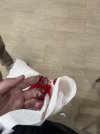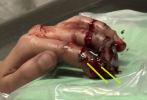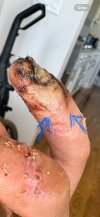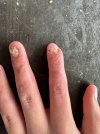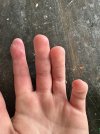I haven't been very active here and there are numerous reasons for that, but the past number of months we've had our attention divided with numerous different parental responsibilities, but most significantly dealing with our second-oldest son, a 14-year-old, who sustained a significant hand injury in a motorcycle accident. There have been many thoughts and feelings as we've gone through this process and I had finally written it out and posted this for family and friends, as they previously had known he'd been involved in an accident but didn't have a lot of specific details. With more time passing and having a much more clear idea on prognosis, I had drafted this to update them, but also to detail my experience going through this both as a parent but also as a professional. I feel that it captures numerous concepts in how I feel a lot of problems need to be assessed and addressed, and a lot of the emphases I put on these in my professional life but also in my training of others (residents and medical students). I feel this situation captures a lot of those elements and they aren't just relevant in a medical setting but are pretty broadly applicable to other situations but do also help inform a bit of context when so many strong opinions are present regarding medical care and so many people get so drastically opinionated about policy this-or-that which tends to fall on partisan lines, and often is a false dichotomy, with the real issues and solutions lying far out of the purview of public awareness. So, in any case, this was our experience:
On October 25, a Friday night, my (just about) 14-year-old son had been out at a friend’s house working on a school project and had taken his minibike there. My oldest (other) son had just gotten his license and he was going to take our 10-year-old to the gas station. My wife had needed me to distract my youngest two kids so my 16 and 10 year olds could slip out. I took the two of them in the backyard to jump on the trampoline. Shortly after this, I heard my wife yelling my name from inside the house and all I heard was something about how there had been an accident. We had just barely gone outside and I had assumed my oldest and third had just backed into something, as there really wasn’t time for them to go anywhere. When I got inside, my wife was on the phone and mentioned that my son, Ethan, was in an accident. She passed the phone to me and one of Ethan’s friend’s dad, whom I had not previously been acquainted with, was on the phone stating that Ethan had an accident with his hand and his bike and that his hand was really chewed up. He mentioned that he was on his way to take him to the hospital. I asked him where he was and where he was headed. My first thought in my mind was needing to know the severity and how to appropriately triage this so that he would go to a facility that had a better chance of having a hand surgeon on call. I tried to inquire how bad this appeared, to which it was hard to get a clarifying answer, other than it was “pretty chewed up.” He was heading to an ER closer to our house that had just opened, but that was a stand-alone ED and would not be helpful. I told him I could meet him where he was at so that I could take Ethan, to which I could hear Ethan yelling out in the background to just go to the hospital. I directed him to another hospital that was still as close, but I wasn’t certain if they’d have a hand surgeon available there, but there would be a better chance. I jumped in the car and had to suppress my feelings until I was able to get there any lay eyes on this to have a better idea of what was going on and what needed to be done. Ethan had texted me saying that he would send me a picture, but told me I “[couldn’t] show mom.” When I arrived, I had seen him with his friend and his friend’s dad at the check-in counter and he was dripping blood. I immediately asked the woman if there was an on-call plastics or orthopedic hand surgeon, to which she didn’t have an answer, and I figured she wouldn’t. At some point, I saw his hand and knew this was much more serious than just a hand injury or being “chewed up.” I can’t really describe what I was thinking, as there were so many possibilities running through my head, but I knew the most important thing I could be doing is securing his evaluation by a hand surgeon immediately, and had to suppress any hypothesizing on my own part. Deep down, I faced the reality that he may very well have his middle and index fingers amputated that night. He had complex lacerations to his three middle digits on his left hand (he’s right-handed). He had two parallel lacerations to his middle finger that left very little skin, with his middle phalanx exposed and fractured, with that entire digit in flexion with him being unable to move it. His index finger was almost entirely severed from the distal part of his middle phalanx and everything was dangling from a very small amount of skin on the medial side.
What we had later learned from Ethan was that he had stopped his motorcycle to check the tightness of his chain. While he was doing that, his leg had bumped the throttle cable where it inserted into the engine, engaging the throttle, and pulling his hand in the chain and in the sprocket and clutch. He was unable to get his hand free and had to manually roll the bike backwards to get his hand out. He called 911. He attempted to flag down three different cars that didn’t stop. The next person who drove by happened to be his friend’s dad.
Sometime after he had been checked in, and after I had reiterated that I needed to know if there was a hand surgeon on call, a nurse practitioner came out into the waiting area and I immediately reiterated that same question, to which she told me that they did have a hand surgeon on call. He was then immediately roomed. I sat there both knowing the severity of the situation and the possible outcome, but not being able to know enough specifics at that moment to be able to give any clarifying information to my wife, but knew she was going to be absolutely heart broken for him when she saw this. They had irrigated the wound and taken x rays but not yet administered anything for pain. He eventually ended up receiving multiple doses of morphine and hydromorphone over a short stretch of time with minimal relief. He declined anything for nausea as he had stated that the nausea was helping distract him from the pain. When the nurse practitioner returned to the room, she stated that she still couldn’t get a hold of the hand surgeon. I had been aware she had been texting over images to him (the radiographs, to my knowledge, and not the actual pictures of the hand [I’ll elaborate more on that later]). When she did get a hold of him, she stated that he couldn’t come in. I later found out that they didn’t really have a hand surgeon on call. They have someone that has hospital privileges there and that they can curbside consult on. Without getting into too much technicality on this, the bottom line was that I needed a facility that actually had a call schedule where someone was designated to be on call for that specialty, and specifically being bound by EMTALA, rather than a curbside consult. She then reassured and stated that worst-case scenario, they could splint him and the surgeon could see him in clinic on Monday. This was astounding to me because I then realized that the nurse practitioner did not understand the emergent nature of this situation and did not convey appropriate information to the surgeon and only radiographs (x rays) to give the impression that the problem here was ultimately an orthopedic problem, when in reality this is a vascular and tissue viability issue and if he waits until Monday (it was Friday), he’s going to lose those fingers.
I’ll hold off on the details surrounding this period of limbo, but long story short, they ended up making contact with the children's hospital where he could see a hand surgeon. He was taken via ambulance. My wife rode in the back with him and I followed. She had later told me that he had expressed to her that he was concerned that he was going to get his fingers amputated. That was hard to hear because I didn’t really have enough nuanced expertise to reassure him or myself but also knew that this was on the table and was possibly more likely than not, and not just one finger.
When we arrived at Children's, we were just taken to the ED to start the process over, though it was a bit quicker. After some amount of time, the fellow and the resident came in (for non-medical people, the resident is someone who has finished medical school and is in specialty training, the fellow is someone who has finished specialty training residency and is doing a fellowship in a sub-specialty [in this case plastic surgery]). I was very relieved to see this as it was the team we most needed to see from the outset and the team that could hopefully be able to bring a little clarity that would answer questions that I could only speculate on as of then. After watching the plastic surgery fellow silently complete his examination, I stood by the bedside as he gave his assessment. He stated the obvious with the complex lacerations on each finger, but started with the ring finger, mentioning that there’d been some extensor tendon damage that they’d be able to repair. He then moved to the middle finger, detailing the difficulty with closure and the type of fracture, but that they would be able to reduce the fracture, pin it, repair the extensor tendon, and close the wounds. The index finger, however, he described as being more of a crush injury, with a lot of missing tissue and not a clean cut at all to reattach this. This would need to be amputated proximal to the distal interphalangeal joint (losing about half of his finger). When he said this, I saw my wife briefly ball over in my periphery before regaining composure. I inquired regarding hypotheticals and, if they were to attempt to reattach it and it were to later fail, would that put us in a different situation other than the one we’re currently in, to which he seemed to indicate that it would not. It’s difficult to describe the thoughts at this time, as we were relieved that the other two fingers would ultimately be okay, but also concerned regarding the one that ostensibly wouldn’t be. Nevertheless, now that we knew a little more, it bought me some time to think about the approach we’d need to take with the surgeon regarding his index finger.
[Reached character limit... see post #2 continued below....]
On October 25, a Friday night, my (just about) 14-year-old son had been out at a friend’s house working on a school project and had taken his minibike there. My oldest (other) son had just gotten his license and he was going to take our 10-year-old to the gas station. My wife had needed me to distract my youngest two kids so my 16 and 10 year olds could slip out. I took the two of them in the backyard to jump on the trampoline. Shortly after this, I heard my wife yelling my name from inside the house and all I heard was something about how there had been an accident. We had just barely gone outside and I had assumed my oldest and third had just backed into something, as there really wasn’t time for them to go anywhere. When I got inside, my wife was on the phone and mentioned that my son, Ethan, was in an accident. She passed the phone to me and one of Ethan’s friend’s dad, whom I had not previously been acquainted with, was on the phone stating that Ethan had an accident with his hand and his bike and that his hand was really chewed up. He mentioned that he was on his way to take him to the hospital. I asked him where he was and where he was headed. My first thought in my mind was needing to know the severity and how to appropriately triage this so that he would go to a facility that had a better chance of having a hand surgeon on call. I tried to inquire how bad this appeared, to which it was hard to get a clarifying answer, other than it was “pretty chewed up.” He was heading to an ER closer to our house that had just opened, but that was a stand-alone ED and would not be helpful. I told him I could meet him where he was at so that I could take Ethan, to which I could hear Ethan yelling out in the background to just go to the hospital. I directed him to another hospital that was still as close, but I wasn’t certain if they’d have a hand surgeon available there, but there would be a better chance. I jumped in the car and had to suppress my feelings until I was able to get there any lay eyes on this to have a better idea of what was going on and what needed to be done. Ethan had texted me saying that he would send me a picture, but told me I “[couldn’t] show mom.” When I arrived, I had seen him with his friend and his friend’s dad at the check-in counter and he was dripping blood. I immediately asked the woman if there was an on-call plastics or orthopedic hand surgeon, to which she didn’t have an answer, and I figured she wouldn’t. At some point, I saw his hand and knew this was much more serious than just a hand injury or being “chewed up.” I can’t really describe what I was thinking, as there were so many possibilities running through my head, but I knew the most important thing I could be doing is securing his evaluation by a hand surgeon immediately, and had to suppress any hypothesizing on my own part. Deep down, I faced the reality that he may very well have his middle and index fingers amputated that night. He had complex lacerations to his three middle digits on his left hand (he’s right-handed). He had two parallel lacerations to his middle finger that left very little skin, with his middle phalanx exposed and fractured, with that entire digit in flexion with him being unable to move it. His index finger was almost entirely severed from the distal part of his middle phalanx and everything was dangling from a very small amount of skin on the medial side.
What we had later learned from Ethan was that he had stopped his motorcycle to check the tightness of his chain. While he was doing that, his leg had bumped the throttle cable where it inserted into the engine, engaging the throttle, and pulling his hand in the chain and in the sprocket and clutch. He was unable to get his hand free and had to manually roll the bike backwards to get his hand out. He called 911. He attempted to flag down three different cars that didn’t stop. The next person who drove by happened to be his friend’s dad.
Sometime after he had been checked in, and after I had reiterated that I needed to know if there was a hand surgeon on call, a nurse practitioner came out into the waiting area and I immediately reiterated that same question, to which she told me that they did have a hand surgeon on call. He was then immediately roomed. I sat there both knowing the severity of the situation and the possible outcome, but not being able to know enough specifics at that moment to be able to give any clarifying information to my wife, but knew she was going to be absolutely heart broken for him when she saw this. They had irrigated the wound and taken x rays but not yet administered anything for pain. He eventually ended up receiving multiple doses of morphine and hydromorphone over a short stretch of time with minimal relief. He declined anything for nausea as he had stated that the nausea was helping distract him from the pain. When the nurse practitioner returned to the room, she stated that she still couldn’t get a hold of the hand surgeon. I had been aware she had been texting over images to him (the radiographs, to my knowledge, and not the actual pictures of the hand [I’ll elaborate more on that later]). When she did get a hold of him, she stated that he couldn’t come in. I later found out that they didn’t really have a hand surgeon on call. They have someone that has hospital privileges there and that they can curbside consult on. Without getting into too much technicality on this, the bottom line was that I needed a facility that actually had a call schedule where someone was designated to be on call for that specialty, and specifically being bound by EMTALA, rather than a curbside consult. She then reassured and stated that worst-case scenario, they could splint him and the surgeon could see him in clinic on Monday. This was astounding to me because I then realized that the nurse practitioner did not understand the emergent nature of this situation and did not convey appropriate information to the surgeon and only radiographs (x rays) to give the impression that the problem here was ultimately an orthopedic problem, when in reality this is a vascular and tissue viability issue and if he waits until Monday (it was Friday), he’s going to lose those fingers.
I’ll hold off on the details surrounding this period of limbo, but long story short, they ended up making contact with the children's hospital where he could see a hand surgeon. He was taken via ambulance. My wife rode in the back with him and I followed. She had later told me that he had expressed to her that he was concerned that he was going to get his fingers amputated. That was hard to hear because I didn’t really have enough nuanced expertise to reassure him or myself but also knew that this was on the table and was possibly more likely than not, and not just one finger.
When we arrived at Children's, we were just taken to the ED to start the process over, though it was a bit quicker. After some amount of time, the fellow and the resident came in (for non-medical people, the resident is someone who has finished medical school and is in specialty training, the fellow is someone who has finished specialty training residency and is doing a fellowship in a sub-specialty [in this case plastic surgery]). I was very relieved to see this as it was the team we most needed to see from the outset and the team that could hopefully be able to bring a little clarity that would answer questions that I could only speculate on as of then. After watching the plastic surgery fellow silently complete his examination, I stood by the bedside as he gave his assessment. He stated the obvious with the complex lacerations on each finger, but started with the ring finger, mentioning that there’d been some extensor tendon damage that they’d be able to repair. He then moved to the middle finger, detailing the difficulty with closure and the type of fracture, but that they would be able to reduce the fracture, pin it, repair the extensor tendon, and close the wounds. The index finger, however, he described as being more of a crush injury, with a lot of missing tissue and not a clean cut at all to reattach this. This would need to be amputated proximal to the distal interphalangeal joint (losing about half of his finger). When he said this, I saw my wife briefly ball over in my periphery before regaining composure. I inquired regarding hypotheticals and, if they were to attempt to reattach it and it were to later fail, would that put us in a different situation other than the one we’re currently in, to which he seemed to indicate that it would not. It’s difficult to describe the thoughts at this time, as we were relieved that the other two fingers would ultimately be okay, but also concerned regarding the one that ostensibly wouldn’t be. Nevertheless, now that we knew a little more, it bought me some time to think about the approach we’d need to take with the surgeon regarding his index finger.
[Reached character limit... see post #2 continued below....]

